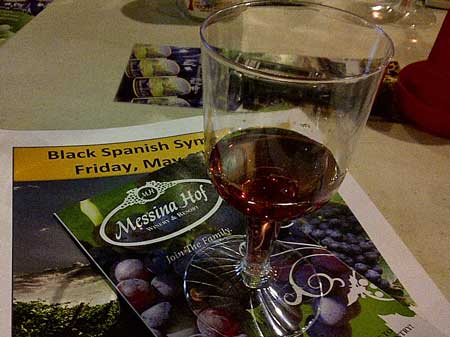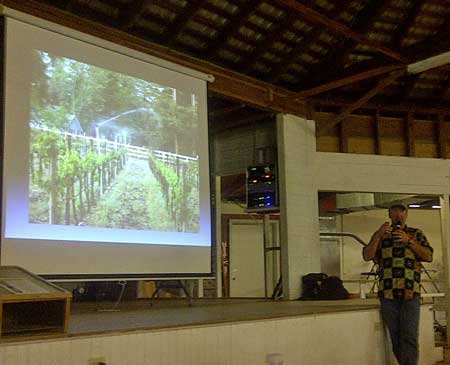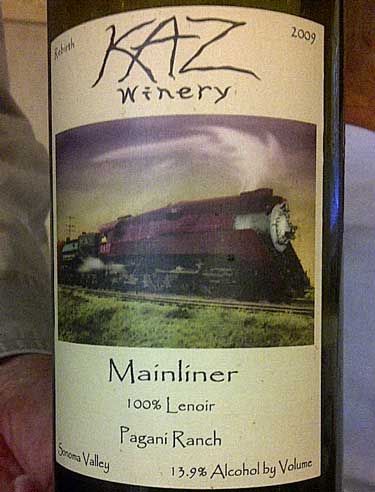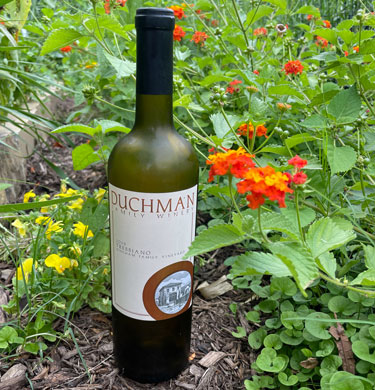What’s a Texas Grape Like Black Spanish Doing in Sonoma?
You better ask Kaz. That’s Winemaker/Owner Richard Kasmier, a.k.a. Kaz who’s the brains and ego behind Kaz Vineyard and Winery who brings you an eclectic line of small batch, unfiltered wines like Kazza Roja, Dirty Does Zin, Moo Vedra, and Red Said Fred!
Last Friday, he was a featured speaker at a Texas wine symposium held in Cat Spring, Texas. What, you’ve never heard of Cat Spring either? Well, let’s start from square one….
Last Friday’s event was called the Black Spanish Symposium sponsored by the Texas AgriLife Extension at Texas A&M. Black Spanish is only one of many names this grape has been given. The grape’s other names include: Le Noir, Lenoir, Jacquez, and Blue French to name only a few. It is the named cultivar of an oldline 19th century bunch grape, derived from a cross between an unknown (likely French) Vinifera and native American Vitis bourquiniana (Vitis aestivalis ?) species that has been used for making wine in the lower Gulf States of the U.S.A.
My research has indicated that was already established and growing in Texas when Italian Francesco Qualia came to here and started Val Verde Winery in Del Rio, Texas in 1883. When Francesco arrived, he found Black Spanish grapes cultivated on a nearby property where he got cuttings to start is own vineyard. The grapevines from the nearby property were, in turn, propagated from a still older vineyard across the border in Mexico. Therefore, the lineage of Black Spanish a.k.a. Lenoir in Texas could be at least 150 years old.
The symposium was both notable and well placed in Cat Spring Texas since there is now more Black Spanish wine grapes planted in Texas than anywhere else in the known world and, along the Texas Gulf Coast, it is only one of a few grape varieties that will grow there, at all. It’s been used in Texas mainly for sweet and Port-style wines, but recently it has been made into a Rosé-style wineby Messina Hof Winery and efforts continue to make it into a dry table wine (See Dry Comal Creek Winery for a particularly good example).
Enter Kaz, stage left…..
He reported that there are all of three vineyards in California that have planted Lenoir, the name for the grape that he prefers rather than Black Spanish. I can’t say that this report makes me think that California vineyards are trying to capture the market for this grape. It seems more like the unusual and mysterious nature of Lenoir fits in with both the eccentrics manifested by Kaz and his wines and the business model for his winery.
The wine he poured for the symposium attendees to taste was Kaz Winery 2009 Mainliner, 100% Lenoir from Pagani Ranch Vineyard. It was thick, opaque, smoky, dry and minerally with a purple-black color and a strong dark fruit component. What Italian roast is to coffee (and a run away train is to transportation) Kaz Winery Lenoir is to wine…not for the faint of heart. Wow, that stuff was powerful, and powerfully good.
Kaz also mentioned that in 2010 he lost his Pagani Vineyard source for Lenoir grapes and consequently his winery will not make a 2010 vintage Lenoir. The entire 2010 crop from Pagani Vineyard was purchased by Ridge Vineyards, one of the famous names in quality wines. In addition to a small quantity of Lenoir, Pagani Vineyards also grows Zinfandel, Mourvedre and Alicante Bouschet. Just think, whoever buys a bottle of Ridge Vineyards Pagani Vineyards wine will be drinking, at least in part, some Lenoir, a varietal to which Texas can lay claim.
If you want to experience Kaz firsthand, check out Wine Biz Radio (the Kaz and Randy Show from Sonoma Valley to your ears). Listen to a new podcast from Kaz and his pal Randy every Friday night. Check it out! I plan to link up with him later this summer at the North American Wine Bloggers Conference in Virginia.






Very interesting. I was wondering how long before the hybrid grapes that do so well in other parts of the country tempt California winemakers. It probably won’t be long before Noiret and Marquette are being grown there. It pleases me, and doesn’t surprise me, that Kaz Winery is among the first to leverage Lenoir. Kaz is my favorite winery in all of California. When I last visited, his pregnant daughter was running the tasting counter from their barn and he was working in the next room over. She told me that they were the smallest winery in Sonoma, making only 1000 cases each year. I loved all of the wines. Beautiful, acid driven wines. And the most unique I’ve experienced in Cali. Maybe Randall Grahm should take note.
I believe that hybrid grapes are just coming into their own. We have new technology and interest for local wines that is being brought to bare. Mike Sipowicz, TX state enologist made a presentation at the Black Spanish symposium that showed the interim results of a first of its kind fermentation study on this grape. It showed that we can likely mitigate the chemical causes of less than optimum Black Spanish wine through better control of the fermenation process. Hybrids like Black Spanish (Lenoir) are definitely easier to grow in fringe areas.
Now, I’d like to know the true lineage of the Lenoir grape and especially what European and American vinifera it owes its DNA.
Hey, thanks for the mention (however brief) about the show. Yeah, Kaz’s Lenoir has always been one of my favorite wines, all the way back when I first experienced it back in 1998. My friends and I at that time were just getting into wine and were all about how big and bold the reds could be. The Lenoir (or Black Spanish, if you must 🙂 was this inky black substance that made other big and bold Cabernets taste like Pinot.
Kaz loved meeting you, and we’re going to be featuring Vintage Texas as our Blog of the Week for our next show recording. We’d love to arrange a time to get you on the phone (or the Skype) and talk with you about it! You now have my email, so get back to me, m’kay?
Cheers!
Lenoir has been grown in California for more than a century. It was used as a rootstock when phylloxera was introduced to Napa/Sonoma — with mixed success, as it resists phylloxera only on certain soils, and fails elsewhere. It was eventually abandoned as a rootstock in favor of more broadly adapted varieites, but was still kept as a winegrape.
Lenoir was also planted in Southern California, solely as a wine grape, since So-Cal was (and is still) phylloxera free. In the 1880s Pierce’s Disease epidemic (then called the “Anahem disease”), which wiped out the Southern California grape industry, Lenoir survived while almost all other vines were destroyed.
Lenoir still appears as a minor element in a lot of old field blend wines in California. And apparently, at least one solid block of it still remains, because Kaz advertises his Lenoir as being from a block of ~100 year old vines.
Lenoir is indeed being grown in SoCal. it serves as a fine stock vine for landscape vineyards, thanks to its disease and heat tolerance.
…. Lenoir, the name for the grape that he prefers rather than Black Spanish…
Lenoir is on the TTB list of approved grape variety names but Black Spanish isn’t, so a wine can’t be varietally labelled as Black Spanish.
Until someone wants to ask the TTB to add it.